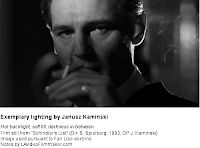Night time shoots can be one of the hardest kinds of lighting setups to master. In order to fully capture the action of the scene numerous different kinds of lighting setups must be incorporated. Lighting a scene at night is particularly difficult as it involves balancing the realism of a scenes lighting with capturing your particular shots well.
Standard Three-Point Lighting Setup
1. The Key Light
The Key Light is usually the most important light that a cinematographer will use to highlight a figures form and dimension. This is the light in which will primarily illuminate our characters' face for example. This light then allows us, the audience, to view the characters facial features and emotions. Without the fill light, a conversation between two characters, for example, will not be captured to its full extent and will hence have less of an impact on the story. The fill lights position can have an effect on the audiences view of the characters. A key light positioned to the side of a characters face will subsequently cast a dark shadow on the other. This shadow can have connotations of the character having something to hide or that they're likely to be untrustworthy and the villain of the story. A notable contrast between high and low key lighting in a scene such as this is referred to as chiaroscuro in art and photography.2. The Fill Light
 Depending on its position facing the figure, the key light will cause a shadow to be cast on a
Depending on its position facing the figure, the key light will cause a shadow to be cast on a characters body. Then the fill light is usually a light of lower key that is used to fill in this shadow to ensure that their whole face for example can be seen on video. Sometimes the use of a fill light will not be necessary as the key light is positioned nearer to the camera lens, this is very common in fashion photography whereby a ring flash is utilised, or the shadow on a character is intentional. Sometimes the fill light will have different hue to the key light which would be used to imply mood.

3. The Back Light
The Backlight is the light in which will usually be positioned behind an object or character in order to illuminate them and hence set them apart from their backgrounds. This illumination can create a silhouette of the character. A notable and iconic cinematic use of backlight is evident in John Ford's western The Searchers (Left). This porch doorway shot has been copied and referenced in many films since.
Butterfly Lighting
The butterfly effect is a lighting setup commonly used in fashion photography to illuminate most of a subjects face. It was most prominently used to illuminate 1930's female hollywood film stars.
When creating this lighting setup, I positioned the model (Francesca Smith) to face the camera directly at eye level. The diffusing 'soft box' light was thus positioned slightly above the camera and faced the model at a slight 70/80 degree angle. This angle and position results in the butterfly effect; a small shadow underneath the nose of the subject thats shaped like a butterfly.
Edge Lighting
Edge Lighting illuminates just one half of a subjects face, leaving the other half in a shadow. This is not usually considered a general purpose lighting technique, however it can be used for many different reasons in film. The most common use for this type of chiaroscuro is to suggest a characters untrustworthiness or deceitfulness as the shadow would suggest another unknown "side" to their personality. This technique is created by facing the light at a 90 or 120 degree angle (the left or right side) to where the subject is facing.
Rembrandt Lighting
This technique is named after the dutch painter of the same name. This lighting technique is created by positioning the light source at about 45 degrees from where the subject is facing. It results in a small triangular shape of light underneath the eye of the shadow side of the face of the subject.
High Key Lighting
High key lighting simply refers to when a shot is overall a particularly high key of light. An obvious way to easily achieve this is to record outdoors on a well lit day. In my example I used a fluid head tripod to smoothly pan almost 360 degrees around, capturing the scenery of the college. This example used is in stark contrast to the low key lighting of the video bellow.
Low Key Lighting
Low Key Lighting (Backlight Silhouette) from Ethan Delaney on Vimeo.
In this clip, I intended to reference the backlight doorway shot in The Searchers. I illuminated my figures face with the use of a mobile phone screen. This is an example of framing within a shot. The doorway acts as the frame, this can add importance to a specific character.



No comments:
Post a Comment